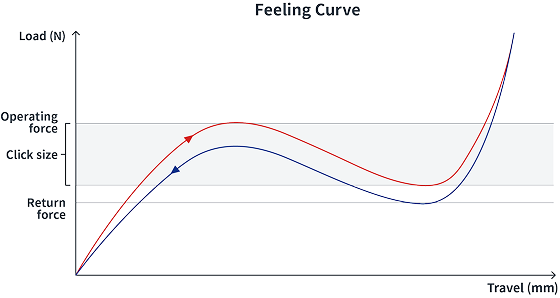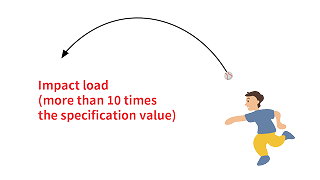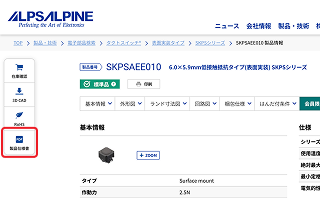Understanding TACT Switch™ Product Specifications
Product specifications for all Alps Alpine TACT Switch™ products listed on our website are available for download. Here we explain the main parameters of the product specifications.
Ratings
Ratings specify the voltage and current ranges within which a switch can operate. Make sure to use the TACT Switch™ within the specified voltage and current ranges.
Ensure that the voltage and current do not exceed the maximum rating or fall below the minimum rating during use.
Electrical Performance (or Electrical Specifications)
Contact resistance
Contact resistance is the resistance value when the switch is closed (on). A consistently low contact resistance allows the equipment to operate normally. It specifies the guaranteed value under the stipulated test conditions.
Insulation resistance
Insulation resistance refers to how hard it is for current to flow (insulation performance) when the switch is open (off). It is normally specified as "100MΩ min." under the stipulated test conditions.
Voltage proof
Voltage proof is the maximum voltage the circuit can withstand (at which insulation will not break down) when the switch is open (off).
Bounce
Bounce is the phenomenon of contact between the contacts becoming momentarily unstable when closing and opening the switch. A prolonged bounce hinders normal operation of the equipment in which the switch is mounted. Bounce is normally specified as “10ms max.”
Bounce differs from chattering in certain switches, like detector switches, caused by vibrations and other factors while the switch is kept closed or open.
Mechanical Performance (or Mechanical Specifications)
See here for more information.

Stopper strength (or Stop strength)
This is the maximum static load that can be applied when the switch is pressed in a typical manner, beyond which performance is not guaranteed*.
As stopper strength refers to a static load, it is not the same as the impact load when an object is dropped on the switch or when the product fitted with the switch is dropped on the side with the switch. For example, a switch hit by a baseball moving at 30–40 km/h will incur an impact load more than 10 times the specification value.

Stem strength
In contrast to stopper strength, this is the maximum load that can be applied when the stem of the switch is pulled, beyond which performance is not guaranteed*.
* If the specification value is exceeded even by a small amount, the product may not immediately break, but performance cannot be guaranteed.
Environmental Performance (or Environmental Specifications)
These specifications measure the degree to which the switch can withstand environmental factors. Specification values are guaranteed under the stipulated test conditions.
Durability (or Endurance Specifications)
Operating life
Operating life indicates that a certain level of performance is guaranteed even after repeated operation under the stipulated test conditions up to the specified number of cycles.
Operating life is not the same as service life.
See here for more about service life.
Vibration resistance
The vibrations with which the switch’s specification values are guaranteed.
Shock resistance
The switch’s specification values are guaranteed when an impact (acceleration) as specified is applied to the switch.
This is not the same as impact load, which is a load directly applied to the switch. This parameter indicates whether the TACT Switch™ can withstand the impact of a product fitted with the switch being dropped, as in the diagram.

Some TACT Switch™ models also guarantee the following specifications based on the anticipated usage.
Models for uses where dust resistance and water resistance are required
A certain level of performance is guaranteed under the stipulated test conditions.
Models subject to IP specifications
IP specifications are met under the stipulated conditions for testing dust and water resistance.
See here for IP6X equivalent, IPX7/X8 TACT Switch™ products.
Models requiring other resistance besides water resistance (e.g. for use in washing machines)
A certain level of performance is guaranteed under the stipulated test conditions.
Models requiring gas-resistant properties (e.g. for use in automobiles)
A certain level of performance is guaranteed under the stipulated test conditions.
Soldering Conditions
Soldering conditions are specified according to the mount type of the TACT Switch™.
Cautions of Use (or Precaution in Use)
Any other precautions that should be taken during use of the product are listed.

TACT Switch™ product specifications can be downloaded from the product’s page on the website.
The TACT Switch™ website is here.
Other basic information about Alps Alpine’s TACT Switch™ products can be downloaded here.
Past articles
-

Understanding TACT Switch™ Product Specifications
April, 2025 -

Characteristics Produced by TACT Switch™ Metal Contacts
April, 2024 -

haptic reactor AFR Series / AFDU Series
March, 2024 -

Achromatic Lenses
March, 2023 -

TACT Switch™ Products with a Long Service Life
May, 2022 -

Internal Resistor Type Detector Switches
November, 2021 -

Features of Force Sensors
March, 2021 -

Air Pressure and Water Pressure Sensors
February, 2021 -

Pressure Sensors
January, 2021 -

haptic reactor AFT Series
November, 2020 -

TACT Switch™ – Realizing Quiet Operation
October, 2020 -

TACT Switch™ – Features and Effects of Middle-Stroke Types
September, 2020 -

TACT Switch™ – Middle-Stroke Types
July, 2020 -

Stick Controllers (ThumbPointer™)
May, 2020 -

Encoders
April, 2020 -

Potentiometer Varieties
March, 2020 -

Potentiometers – What Are They?
February, 2020 -

Alps Alpine's Humidity Sensors
January, 2020 -

Features of Spring Contacts
September, 2019 -

Spring Contacts – What Are They?
August, 2019 -

Features of Slide Switches
July, 2019 -

Detector Switch Varieties
July, 2019 -

A Special Feature of Detector Switches
June, 2019 -

Features of Resistive Position Sensors
April, 2019 -

Resistive Position Sensors
April, 2019 -

Angle Sensor
November, 2018 -

2-in-1 Encoder with Variable Magnetic Pole Pitch
October, 2018 -

Magnetic Sensor
September, 2018 -

TACT Switch™ as a Multifunctional Key
July, 2018 -

Factors Determining the Feel of a Switch
June, 2018 -

Having Trouble with Contamination of Electrical Contacts?
May, 2018